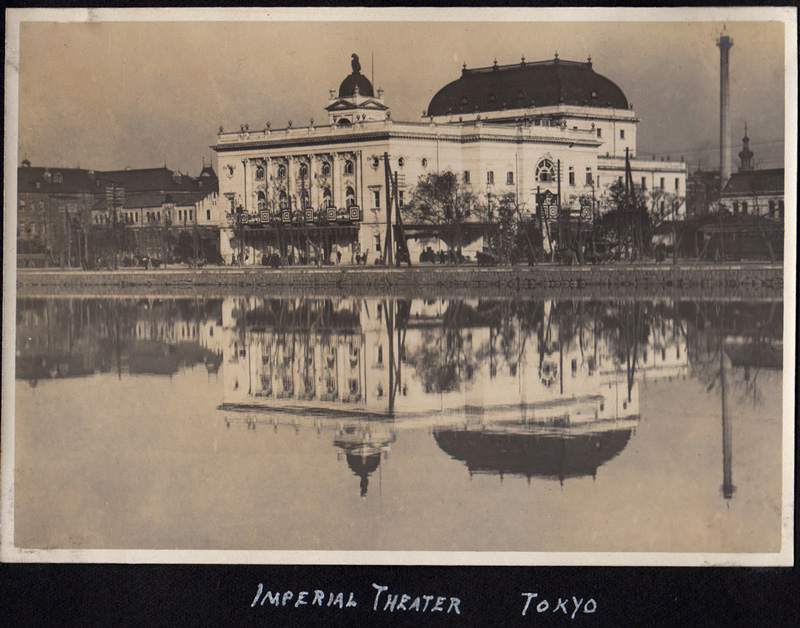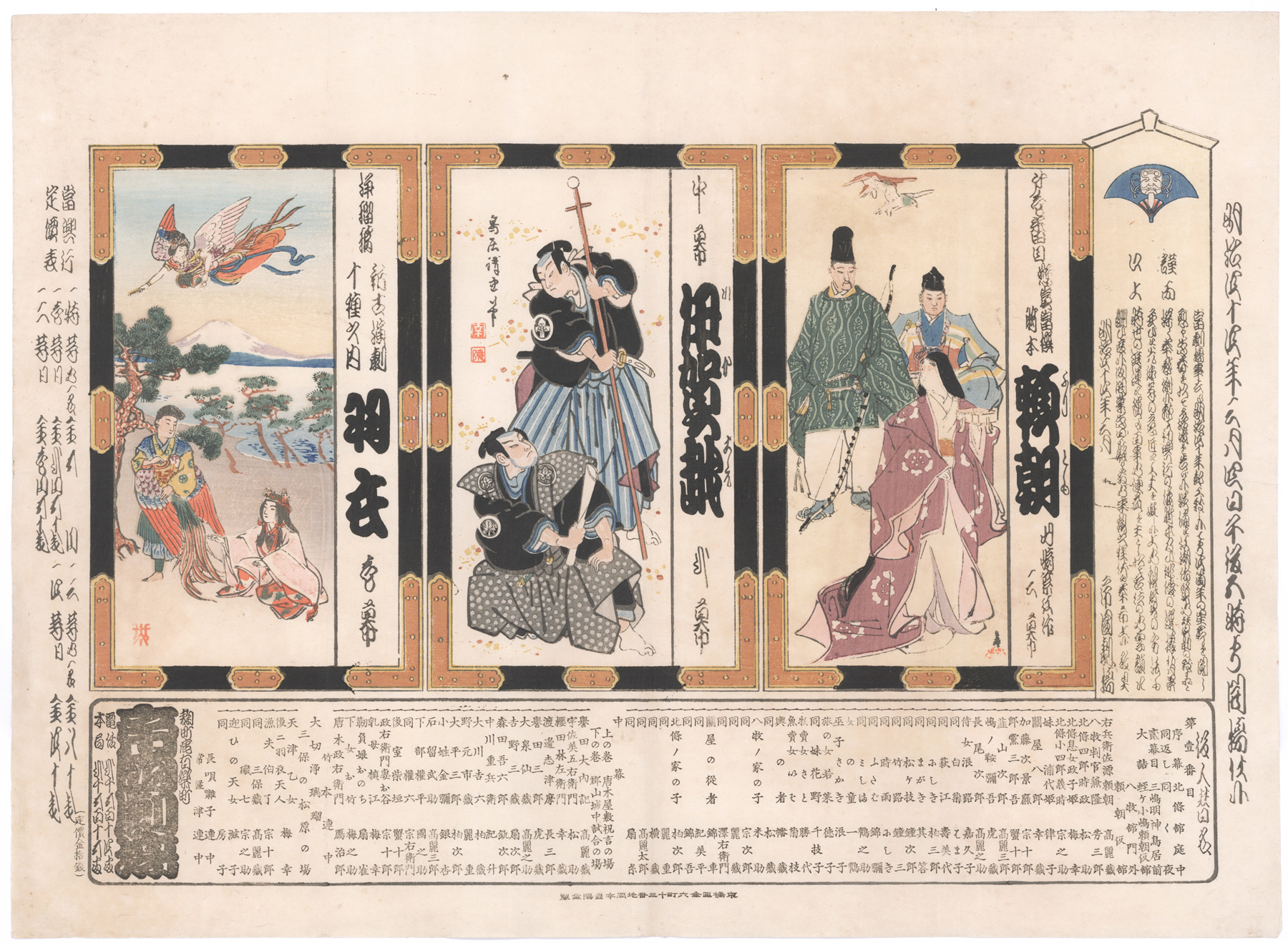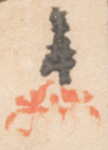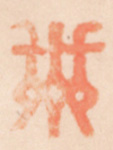About This Print
The playbill from the opening performances in March 1911 at the new Imperial Theater (Teikoku gekijō). The three plays illustrated are (from right to left) Yoritomo 頼朝, Igagoe 伊賀越 and Hagoromo 羽衣, brief descriptions of which are provided below, along with an American reporter's on-the-scene critique of the theater opening and the plays. In addition to the play names being given in the illustrations, they appear again with details of their various scenes in the rectangular box at the bottom of the print, along with the names of the cast members and their roles, and the theater name written in kanteiryū, a special calligraphy used in the Kabuki theater. Among the many cast members are the three leading actors of the Imperial Theater's in-house troupe, Onoe Baikō 尾上梅幸 VI, Ichikawa Komazō 市川高麗蔵 VIII and Sawamura Sōjūrō 沢村宗十郎 VII.The Plays: Yoritomo, Igagoe, Hagoromo - A Brief Summary
The Sunday Oregonian.(Portland, Ore.) October 22, 1911

BY P. BECKWITH DAVIS.
TOKYO, Japan. (Special.)
The new million yen Imperial Theater which opened recently is thesensation of Tokyo. The first two days and nights were devoted to opening ceremonies,Baron Shibusawa presiding. There was much oratory, followed by Japanesesketches by old-school actors and modern presentations by artists of the newschool, winding up with a grand ballet in which the Japanese actresses, attiredin the fancy costumes of the real musical comedy order, performed the foreign danceswith remarkable ease and grace.
After a one-day intermission to let theexcitement subside, the regular Japanese performance, which is to run throughoutthe month, made its debut. The house was packed with Japanese to its full 1700seating capacity. There were but 60 foreigners in the house, guests of ManagingDirector Aisaku Hayashi of the Imperial Hotel. The foreign gentlemen were inevening dress, while the ladies of the party wore gowns and opera coats of the latestParis fashion. Japanese as a rule are not particular what they wear, although alarge proportion of the higher class have adopted European clothes. In back ofthe foreigners, who were seated in the front center rows of the orchestra, werea number of Japanese society ladles dressed in dark colored kimonos with theirhair done up three-leaf clover style, or to use a better illustration, like"your uncle's" trade mark-three balls-one on top and one on either side,with a wad protruding in the back. Among these were some elderly ladles who didn'thave much hair left and this was coiled into a little round knob in the back.In general appearance they resembled scrubwomen who invade the offices of thebig buildings in American cities after the high financiers and their hirelingshave done their day of toil. Further to the rear sat one Japanese lady ofrefined features, with her breasts bared, nursing a babe throughout theperformance. Near her sat a comely Japanese matron with her daughter, astrikingly handsome girl. When she smiled, although she was of the pureJapanese type, she looked very much like some of the American beauties whichgrace the summer seaside resorts.
Many of the Japanese women nestled into the handsome silkupholstered chairs with their feet sticking up their back. The chairs are builtso that the seats may be slipped forward and the backs down to meet, so thatthe occupants may huddle in Japanese fashion, while Europeans and modernJapanese can sit up and take notice with their feet on the floor without movingthe seats.
The Japanese men were robed in all manner of fashions, as theyusually are. Some wore divided skirts that hung full down to their ankles andwere just tied on around the waist with no belt, and a low V-cut dark waistwhich showed all kinds of undershirts at the neck, the sleeves of theundershirts hanging down over their wrists. Over this characteristic attirethey wore dark kimonos with a little white figure between the shoulder blades.They wore no shoes, for their sandals that pass for shoes were left outside. Inthe lobby. During the Intermissions this motley throng rambled about the foyersand lobbies, some taking light refreshments in the tearooms to the right of theauditorium or drinking wine in the cafe to the left, while others patronizedthe magnificent restaurant on the second floor back of balcony, or sipped tea,served by little Japanese maids in black frocks and white aprons, at a longtable in the palatial first balcony lobby. Numbers of these little maids areemployed to attend to the patrons.
The splendor of this playhouse places it among the show buildingsof the world. Its marble pillars and balustrades, the white and gold decorationon pale blue background in the auditorium, together with myriads ofincandescent lights, make it a veritable palace. The stage is tremendous, the sceneryand lighting effects well carried out and, from a Japanese point of view, theacting is simply perfection. The Inflections of voice, grace and harmony ofgesture and scenic displays indicate a high order of work, but the weird wails and uncanny sounds that accompany the plays are distracting to the foreigner,who is unable to grasp their meaning.
"Yaritomo," [sic] the first play given, starts about 5 o'clockin the afternoon and runs until about 8 in the evening. The "Garden ofHojo’s Mansion" upon which the curtain rises in the first, act is amagnificent stage setting. The love scene between Mr. Komazo Ichikawa as Minamoto-no-Yorimotoand Mr. Baiko Onoye as Masako under the camphor tree, is a clever presentation.The scene before Torii, the sacred arch of the Mishima Myojin shrine, is a reliableproduction of dramatic art. A unique feature of the theater is the revolvingstage which is used in the last act to give the action in the garden in frontof the wall surrounding Yoritomo's garden, and then turns and shows theconflict between the forces of Hojo and Yamaki on the other side of the wall.
After this play is a short intermission and then Ganjiro [sic], the mostfamous Japanese tragedian, is seen in an old Japanese melodrama entitled"Igagoe," in two acts. The dialogue of this play runs from the highhead tones to low growls and snarls and is accompanied by two musicianssquatting on a platform to one side and a bunch of wailers in a dungeon-likeenclosure high up at one side of the stage, with bars running up and down infront of it. While the actors are struggling with their gutteral tones anddoubling up till their heads touch the floor in mutual obeisance, the musiciansand maniacs are making the most fiendish noises imaginable, sometimes yelpinglike dogs, with a prolonged howl at the end, and now and then clucking andcrowing like chickens. This infernal racket is rendered more hideous by thebeating of drums that produce hollow, discordant sounds like Indian tom-toms,and the incessant plunkety-plunk of one stringed guitars that produce novibration.
The last performance of the evening closes at midnight. It is called"Hagoromo." This is a series of grotesque dances. The performers comeout from a curtained enclosure at one side of the house and begin their dancingwhile on the way to the stage, thus performing in the midst of the audience. Thedancing consists of hopping around and squirming, the evolutions resembling asnake's contortions. There is a grand finale with a fairylike creature withspangled wings and long tail feathers like a bird, ascending intothe air near the proscenium arch, where she is joined by two others attiredlikewise, the scene slowly ascending until the fairies appear to be hovering inthe clouds.
Kabuki Playbills (Tsuji Banzuke)
The Imperial Theater
 photo taken between 1914 to 1918 Source: https://www.flickr.com/photos/adavey/5075680124 | Tokyo’s first purely Western-style theater, opening in March 1911, the Imperial Theater (Teikoku gekijō) “was a highly Gallic structure of marble, hung with tapestries, and provided with seventeen hundred Western-style seats”3 designed by the Japanese architect Tamisuke Yokogawa (横河民輔, 1864–1945). Situated beside the Imperial Palace moat, on the western edge of Mitsubishi Meadow, “it was the place for gala performances.”4 “Its management included various prominent persons connected with the 'Association for the Improvement of Drama' (Engeki Kairyōkai), among them members of the aristocracy, politicians and businessmen. It also employed its own kabuki actors [the three leading actors being Onoe Baikō VI, Ichikawa Komazō VIII and Sawamura Sōjūrō VII;; it started presenting plays with actresses, and even put on kabuki with |
Print Details
| IHL Catalog | #1263 | |||
| Title or Description | Kabuki Playbill (Tsuji banzuke) for Plays at the Initial Opening of the Imperial Theater: Yoritomo, Igagoe and Hagoromo 辻番付 帝国劇場初開場番付 頼朝 伊賀越 羽衣 | |||
| Series | ||||
| Artist | Torii Kiyotada VII (1875-1941) | |||
| Signature |
| |||
| Seal | as shown above | |||
| Publication Date | March 4, 1911 明治44年3月4日 | |||
| Publisher | Okamoto Toyoharu as printed in the center of the lower margin: 京橋区金六町十三番地 岡本豊陽堂製 Kyobashi-ku, Kinroku-cho 13-banchi Okamoto Toyoharu sei | |||
| Impression | good | |||
| Colors | excellent | |||
| Condition | good - full size; 3 full-length vertical folds | |||
| Genre | tsuji banzuke 辻番付 | |||
| Miscellaneous | | |||
| Format | vertical oban | |||
| H x W Paper | 14 x 19 1/4 in. (35.6 x 48.9 cm) | |||
| Literature | ||||
| Collections This Print | Rekibun Digital Museum 14200160; Tsubouchi Memorial Theatre Museum Digital Archives Collection of Waseda University ro18-00092-0021AZ |





